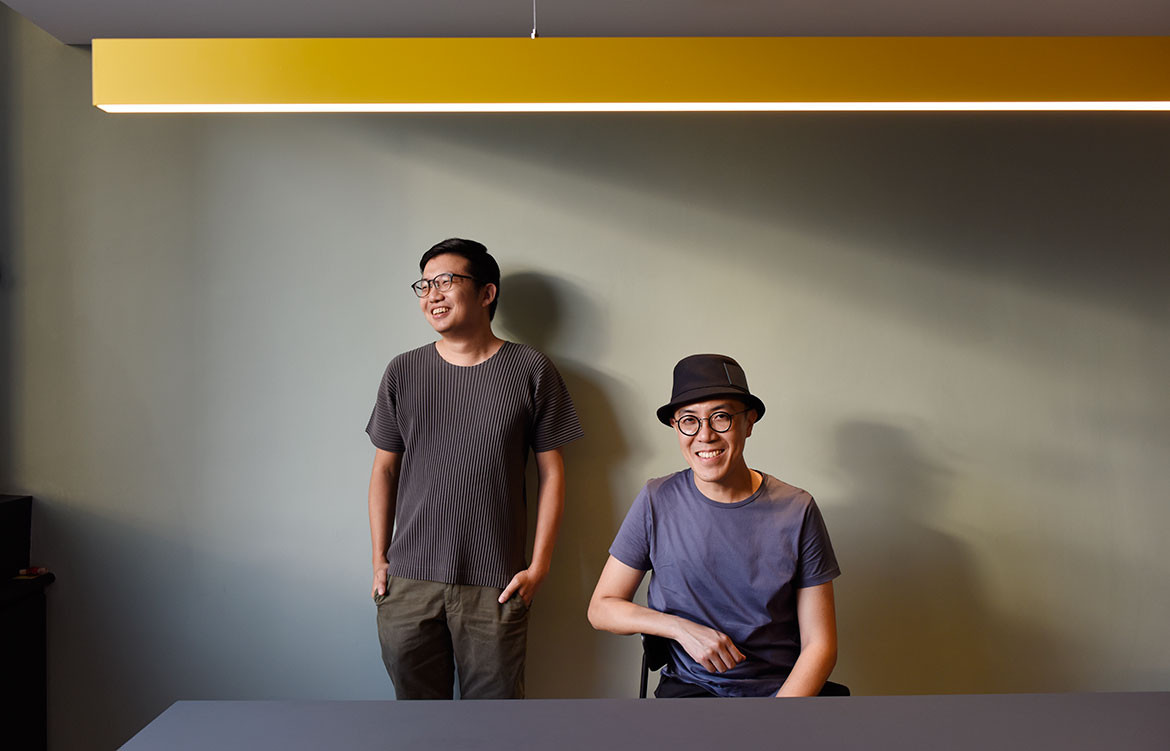Taking one look at Wynk Collaborative’s portfolio of latest commercial and residential projects, and it may seem like the studio’s bold and vibrant approach to crafting spaces has always come naturally to the design partners: Leong Hon Kit and Si Jian Xin. Not so, says Hon Kit, and divulges that during the firm’s formative years Jian Xin and he, both coming from architectural backgrounds, had an initial hesitation to experiment with colours and remained within the comfort of the more neutral palettes and patterns.
Hon Kit and Jian Xin recall a shift in attitude, while working on a residential project several years back (Pink & Mint Apartment), where the duo decided to integrate a full-height pink storage wall in the apartment’s living space and explore the usage of mint tiles in the kitchen. “From then onwards, we started experimenting with pops of colour which to us became an effective strategy to easily accentuate a space and give it a lot of character without breaking a bank,” says Hon Kit. “Commercial projects that came later on just gave us more leeway to use funky colours and textures.”
Love, Bonito
Wynk is able to innovate by integrating digital elements within the physical space – a trend that has been driving retail design.
Since then, the evolution of Wynk’s aesthetic can be traced in a steady direction over the years, taking on a more daring approach to textures, patterns and colours, with its latest interiors for Love Bonito, Standing Sushi Bar at Marina One, and Habitat by Honestbee showcasing the ease and comfort with which the firm now drives the visual experiences for different spatial typologies, each distinct from one another. “With every project we learn something new and we do something different,” explains Jian Xin. “We try to push ourselves and not repeat exactly what we have done in the past.”
And while colour and vibrancy may have the most noticeable presence in Wynk’s projects, at the heart of the firm’s design ethos is, ultimately, the user experience, whether it is in a residential or commercial space. According to Hon Kit, this is where the collaborative part of the design process becomes instrumental, where details are ironed out with a client through ideation and sharing. This is also where Wynk is able to innovate by integrating digital elements within the physical space – a trend that has been driving retail design – by working with the client to define what bridging the virtual and physical aspects of commerce may look like.
“We respect our clients’ briefs and how they think the space should run, and I think, in turn, our clients like how open we are to different ideas and ways of looking at things,” says Hon Kit. As far as the company’s philosophy goes, this willingness to stay open and receptive to collaboration has enabled Wynk to tackle projects within new and hybridised typologies. Case in point is the Honestbee office that was designed more like a playground with plenty of social spaces where people can exchange ideas, or Habitat by Honestbee, designed as one part a high-tech supermarket and another part a communal space.
Standing Sushi Bar
As the roster of projects and typologies under Wynk’s wings expands, both Hon Kit and Jian Xin remain adamant that they do not want to become experts in any one field. “Projects like Habitat by Honestbee have taught us to be more inclusive of other disciplines – technology, branding, UX/UI design play a big part in designing holistic experiences and engaging users with their environments,” says Jian Xin.
During the Wynk’s formative years Jian Xi and Hon Kit had an initial hesitation to experiment with colours and remained within the comfort of the more neutral palettes and patterns.
For Hon Kit and Jian Xin, the constant process of learning and looking to innovate within different types of projects and typologies is what continues to keep them relevant in the increasingly competing design scene, locally and internationally. “While aesthetically, we try to be different with every project that we do, the lessons that we learn from one type of project, we can apply to the next where relevant,” explains Hon Kit. “This shapes our methodology of design and how we think, so we are always keeping an open mind.”
Wynk Collaborative
wynkcollaborative.com
Photography courtesy of Wynk Collaborative
Pink and Mint Apartment
Honestbee Habitat
Honestbee Office
We think you might also like the Mantab Group by S/LAB10

